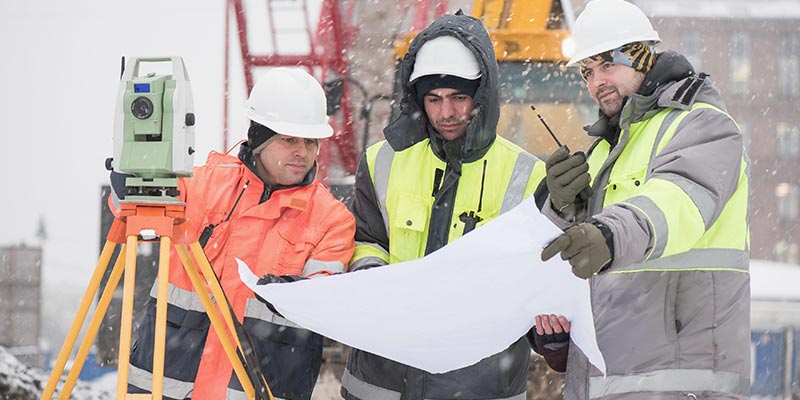Using Temporary Heaters on Construction Sites

Temporary heating devices play an important role in working effectively during cold weather. They allow temperature-critical work to continue and provide a more comfortable working environment. Improper selection and use, however, can lead to worker injury or property damage from burns, carbon monoxide poisoning, oxygen- deficient atmospheres, fires or explosions.
Common Temporary Heating Solutions for Construction
Temporary heating devices, available in various models from different manufacturers, generally fall into three main categories: direct-fired, indirect-fired and electric.
Direct-Fired Heating Devices
Direct-fired heating devices, often called “salamanders” or “torpedoes,” are the most common type used in North American construction.
- Fuel Types: These devices use propane, diesel, natural gas or kerosene.
- Operation:These units pull air from the heated room directly across an open flame and force it back into the room.
- Advantages: These devices are nearly 100% efficient and inexpensive to operate, and radiant heat models don’t require electricity, which is helpful in the early construction stages when temporary electrical service may not be available.
- Drawbacks: These units can deplete the oxygen level in the room and accumulate toxic levels of carbon monoxide, making the work area unsafe. Adequate ventilation is required, and clear space must be maintained between the unit and combustible materials to help prevent ignition.
Indirect-Fired Heaters
Indirect-fired heaters are becoming increasingly popular in the construction industry.
- Fuel Types: These devices use natural gGas, propane or diesel.
- Operation: Located outside the building, fuel is burned in an enclosed combustion chamber that draws combustion air from outside. The flame heats a heat exchanger, which indirectly warms outside air that is fan-driven into the building via air ducts.
- Advantages: These devices offer increased safety and reduced fire risk since the burner and fuel source are outside, and fresh air is provided to the workspace, which can minimize carbon monoxide and oxygen depletion concerns.
- Drawbacks: These devices require electricity to run and are less efficient than direct-fired units.
Electric Heaters
Electric heaters are the third type and are growing in popularity.
- Types: These devices use forced airor radiant, with forced air units also referred to as ‘salamanders.’
- Operation: Electricity passes through a resistive coil, producing heat. A fan draws room air across the coil, transferring heat to the air, which is then forced back into the room, or the heat from the coil simply radiates into the room.
- Advantages: These devices offer clean heat with no emissions, easy maintenance and no on-site fuel storage.
- Drawbacks: These devices require electricity, which may not be available in the early construction stages, and can be expensive.
Safety Ranking of Temporary Heating Devices
Considering worker and fire safety, temporary heating devices are listed below from least to most hazardous:
- Electric radiant or forced air heating units: These units should be equipped with high- limit cut-offs and tip-over switches and they should be UL-listed.
- Indirect-fired heating unit located outside the building, either natural gas or diesel: Natural gas is best if the service line has been installed for the site. This allows for hard-pipe connections of the fuel source to the heating unit. Diesel fuel reduces the likelihood of fire due to its lower combustibility when compared to tanked gases. The units should be CSA (Canadian Standards Association) or UL-listed, regardless of whether they are used in the U.S. or Canada.
- Direct-fired, propane or natural gas: Adequate clear space should be maintained from all combustible materials. The units should be equipped with tip-over safety switches and installed on a non-combustible floor. As an added measure, these units should be secured to help prevent tipping and should be caged to help prevent persons or combustible materials from coming into contact with the hot surfaces. Gas storage cylinders should be located outside the building, secured from tipping, and protected from vehicular traffic. The units should be CSA (Canadian Standards Association) or UL-listed, regardless of whether they are used in the U.S. or Canada.
Temporary Heating Regulations and Standards for The Construction Industry
In the United States, the use of temporary heating devices on construction sites is covered by OSHA’s Construction Standard, part 1926.154(a)(1). This outlines ventilation requirements along with clearance, mounting and protection parameters.
In Canada, the use of temporary heating devices on building construction sites is covered by the Occupational Health and Safety Regulations, under the Canada Labour Code, SOR/86-304 part 2.17.
All heating devices should be CSA (Canadian Standards Association) or UL- listed, regardless of whether they are used in the U.S. or Canada. In addition, all devices should be used and maintained per manufacturer specifications.









